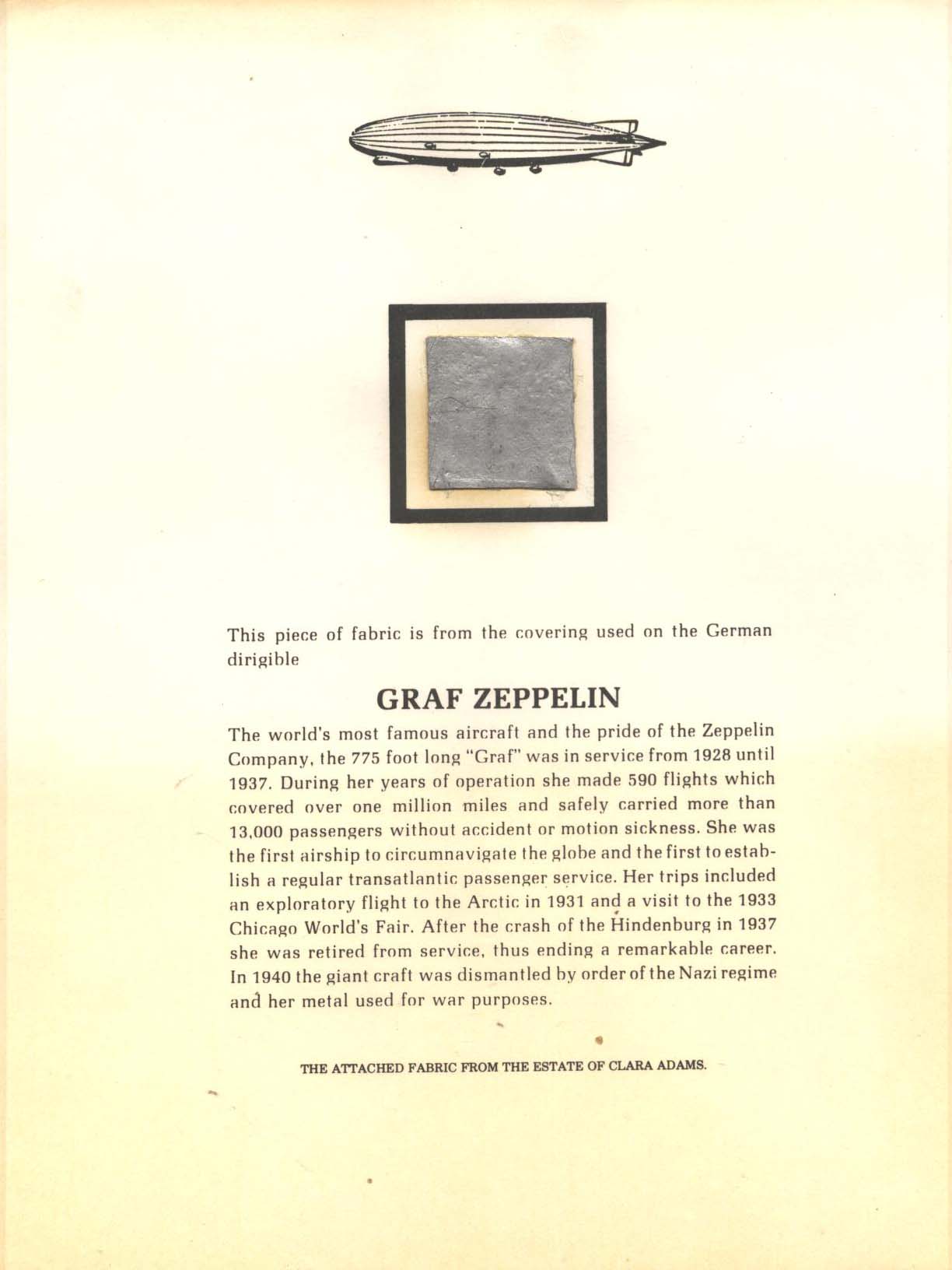
|
GRAF ZEPPELIN FABRIC
Graf Zeppelin Fabric
The Graf Zeppelin ruled the uncluttered skies like no other monarch could. The sight of the silver ship gliding over head brought crowds of people streaming from their houses and into the streets. No other aircraft in history , with the possible exception of the Spirit of St. Louis, has been the focus of so much admiration by so many people. The Graf Zeppelin was Dr. Eckner's crowning achievement in the concept of the zeppelin. Even though the Hindenburg and the Graf Zeppelin II would be technologically superior to the Graf Zeppelin, no other air ship would be so loved by nearly all the world. The size of the Graf was dictated only by the inner dimensions of the construction hanger. When completed, the airship was 100 feet in diameter, and 110 feet high including the gondola bumpers, bringing her within TWO FEET of the rafters of her shed. Many new innovations were incorporated into the Graf Zeppelin during her construction in Factory Shed number II in Friedrichshafen. The most revolutionary of the innovations was the inclusion of a new fuel system for the engines. Previously, all airships had used engines that burned either gasoline or diesel fuel. The main problem with using a liquid fuel was that as you burned off the gas or diesel, you lost weight, and as you lost weight, you had to vent off hydrogen to keep from floating up. This had been a problem that had plagued zeppelins since the beginning, but was solved in the building of the Graf. The Graf had special gas cells installed below the gas cells that housed the lifting hydrogen gas. These new cells comprised approximately 1/3 of each bay within the ship and each cell was filled with a new fuel called "Blau gas". Invented by Dr. Hermann Blau, this gaseous fuel would account for 750,000 cubic feet of the volume of the Graf, which had a total volume of 3,707,550 cubic feet. The wonderful thing about the blau gas was that it weighed about as much as air and so did not hamper the ship with the weight that liquid fuel would, also,as the fuel burned in the engines of the ship, no weight was lost by its consumption and therefore no hydrogen would be vented. An engine car complete with blau gas / diesel burning engine. Note the handling rails along the bottom along with the struts and stringers attaching the car to the ship. The propeller would be attached to the right as a pusher type. Even with all her new design innovations and the excitement of the German people, the Graf Zeppelin was slowed by of lack of money. It had taken a plea to the German people by Dr. Eckener to raise most of the money to have her built and more arm twisting in the government to get enough to finish the ship, now he needed money to keep her flying. That money was found in the hands of an American business man and airship supporter named William Randolph Hearst. Hearst would make a business deal with Dr. Eckener that would appeal to both the Zeppelin Company and Hearst's newspaper companies. Hearst would put up the money for a global flight of the Graf Zeppelin that would be the gain her the publicity she would need to form a solid reputation for dependability and he would get exclusive U.S. rights to the story. Dr. Eckener, having been a journalist and writer before working for the Count VonZeppelin, knew how to make the most of this publicity and did so at every opportunity. The global flight would begin in Friedrichshafen and proceed to Lakehurst, New Jersey. Lakehurst would then mark as the official starting point of the journey as stipulated in the contract drawn up by Hearst. From Lakehurst back to Friedrichshafen, to Tokyo and then to San Francisco, Los Angeles and back to Lakehurst. Although the Graf was not the first aircraft to circle the globe, it was by far the fastest. What took months for a British military, heavy bomber to do, with many breakdowns and hardships, the Graf did in 12 days and 11 minutes in comfort and style with a full passenger load over much previously uncharted land. The trip was a complete success and the world, particularly the U.S., caught Zeppelin Mania. Once safely moored at Lakehurst, Dr. Eckener was treated to a ticker-tape parade in his honor in New York City and the news papers would dub him the "Magellan of the Air". Left: The control car showing the rudder wheel. the elevator wheel is mounted to the left, out of view. The two wheel like objects in the upper right are actually engine telegraphs with three more being out of shot. Right: The Graf under construction. The structure is about half complete. A ring is laying on the floor and will soon be added to the structure. If you look carefully, you can see the central triangular keel running through the length of the ship just low of the center LZ-127 Graf Zeppelin Statistics Length 776 feet / 236.53 meters Diameter 100 feet / 30.48 meters Gas Volume 3,700,000 cu. feet / 111,000 cu. meters Engines Five 550 hp Maybach engines Maximum Speed 80 mph / 128 km/h Lifting Gas Type Hydrogen
Price: $275.00
Please contact us before ordering to confirm availability and shipping costs.
Buy now with your credit card
other ways to buy
|


